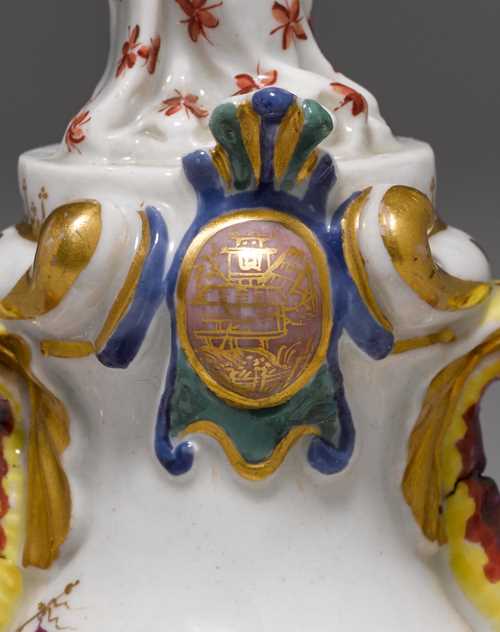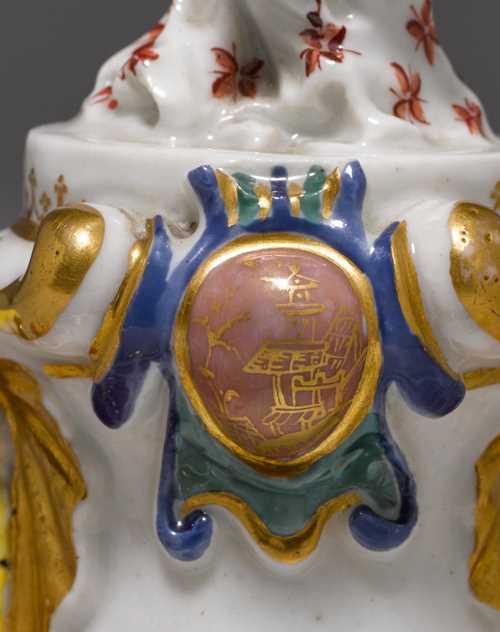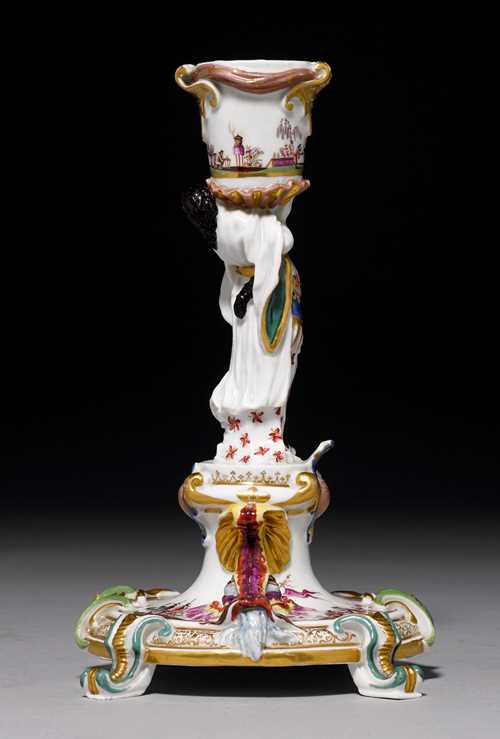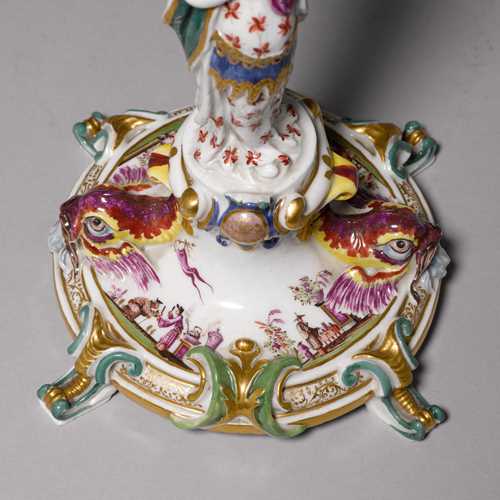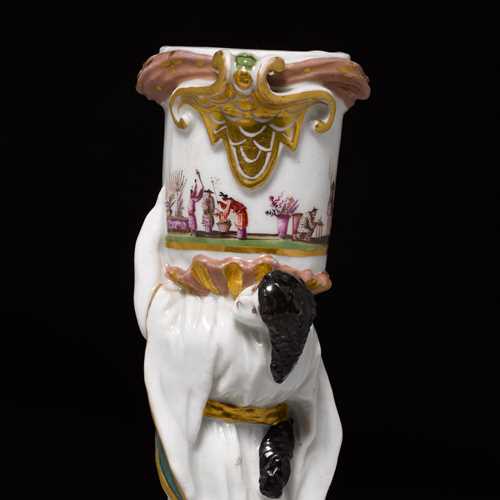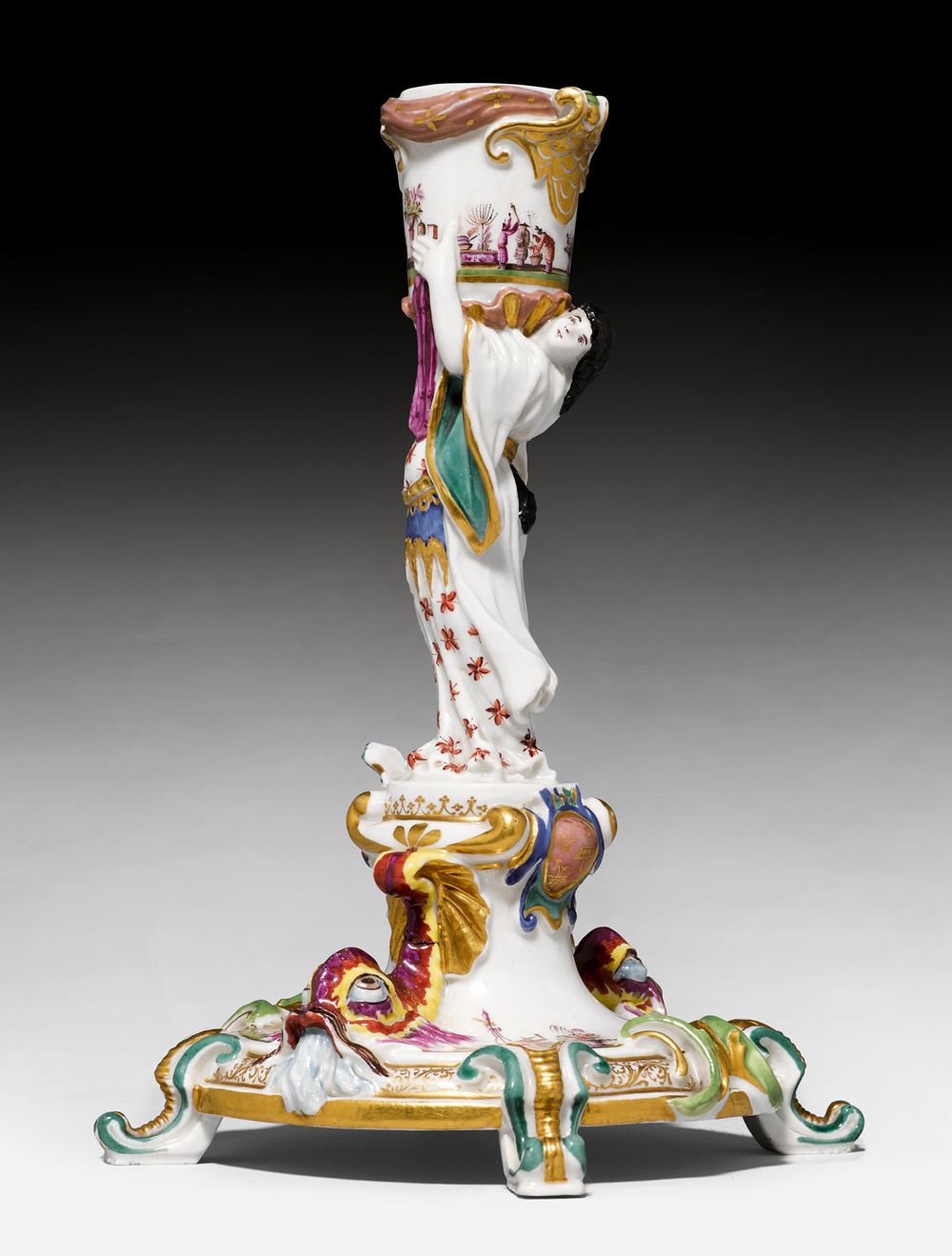
Lotto 1073 - A184 Arti decorative - giovedì, 22. marzo 2018, 10h00
EXTREMELY RARE MEISSEN CANDLESTICK
- in a German private collection since the 1960s.
Exhibition:
Mittelrheinisches Landesmuseum Mainz - "Keramik aus Privatbesitz", Ausstellung der Gesellschaft der Keramikfreunde E.V. 'KERAMOS' in collaboration with the Mittelrheinisches Landesmuseum (Pavilion), 10 May - 4 June 1979, No. 108.
Illustration:
- Mitteilungsblatt der Keramikfreunde der Schweiz (KFS) No. 61, 1963 (cover photograph).
- Sotheby's London, Continental Ceramics, 26 November 1985, Lot No. 290.
The only known comparable item has been in the Rijksmuseum Amsterdam since 1976 (Inv. No. BK-1976-50).
This candlestick is worthy of a museum collection – there is only one other, nearly identical model in existence, which has been in the Rijksmuseum in Amsterdam since 1976. In the catalogue of the museum collection of Meissen porcelain, reference is made to the candlestick offered here, located in a German private collection since the 1960s (Abraham L. den Blaauwen, Meissen Porcelain in the Rijksmuseum, 2000, cat. no. 51, pp. 102, 103).
Johann Gottlieb Kirchner (born in Merseburg in 1706) came to Meissen as a modeller on April 29, 1727 from Dresden, where he most likely lived with his much older brother Johann Christian Kirchner, who assisted the court sculptor Balthasar Permoser (1651-1732) with the decoration of the Zwinger in Dresden. In the same year that the candlestick was created, Kirchner designed and modelled a Temple of Venus with niches in the style of the nymph bath in the Zwinger, in which he placed figures corresponding to the figural type of the candlestick shaft (Rijksmuseum catalogue, 2000, cat. no. 50). In the catalogue text for the Temple of Venus, Den Blaauwen points to the parallels to Permoser‘s sculptures from circa 1705 that he created for the garden of a merchant in Leipzig (op. cit., p. 101).
The combination of figurative sculpture with Höroldt chinoiserie can be found in various works by Kirchner, including the Temple of Venus, the pedestal base of which is painted with equally fine Höroldt chinoiserie as on the candlestick and on a goblet also held in the Rijksmuseum, Amsterdam (op. cit. p. 100, cat. no. 50 and 49); additional comparisons include Kirchner's clock case from the Königlichen Sammlungen in Dresden (inv. no. P97) and in the Arnhold Collection (Cassidy-Geiger, The Arnhold Collection of Meissen Porcelain 1710-50, 2008, cat. no. 33), and a further clock case from 1727, a cooperation between George Fritzsche and Kirchner. (Rijksmuseum, cat. no. 48).
In October 1727, Kirchner had worked on "eine gewisse Façon Tisch Leuchter mit Zierrathen"; models in clay were further formed by Georg Fritzsche, the "most skilled and best moulder and embosser" according to Kirchner. (Zimmermann, Kirchner. Der Vorläufer Kaendlers an der Meissner Manufaktur, Berlin, 1929, p. 5; Walcha, Das Charakterbild Kirchners im Spiegel der Meissner Archivalien, Mitteilungsblatt KFS 53/54 1961, p. 24). It is highly probable that these notes by Kirchner refer to precisely this candlestick, with its central female supporting figure stylistically similar to the Kirchner‘s figure type for the Temple of Venus from that same year (op. cit. cat. no. 50).
Works by Johann Gottlieb Kirchner are rare. He is compared to the factory’s other two famous artists: J. J. Kaendler (active 1731-1775) and J. G. Höroldt (active 1720-1765). Kirchner was active for only a short time at the factory: first from 1727 to 1728, and after a two-year break (he was dismissed due to his ‘disorderly life-style‘), again from 1730 to 1733, then once more in 1737 as a model master. Among his most prominent works are the large animal figures for the long gallery in the Japanese Palace in Dresden. Kirchner's style was ground-breaking for his successor Kaendler, who was initially his subordinate, and also for subsequent European porcelain sculpture. Writing about Kaendler in March 1732, the official Commission wrote that he was exceeded by Kirchner "in his inventions and otherwise" (R. Rückert, Biographische Daten der Meissener Manufakturisten des 18. Jahrhunderts, 1990, pp. 113, 114).
CHF 40 000 / 70 000 | (€ 41 240 / 72 160)
Venduto per CHF 78 500 (incl. premio dell'acquirente)
Non si assume alcuna responsabilità per la correttezza di queste informazioni.


